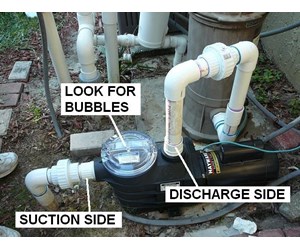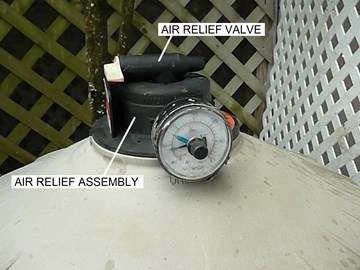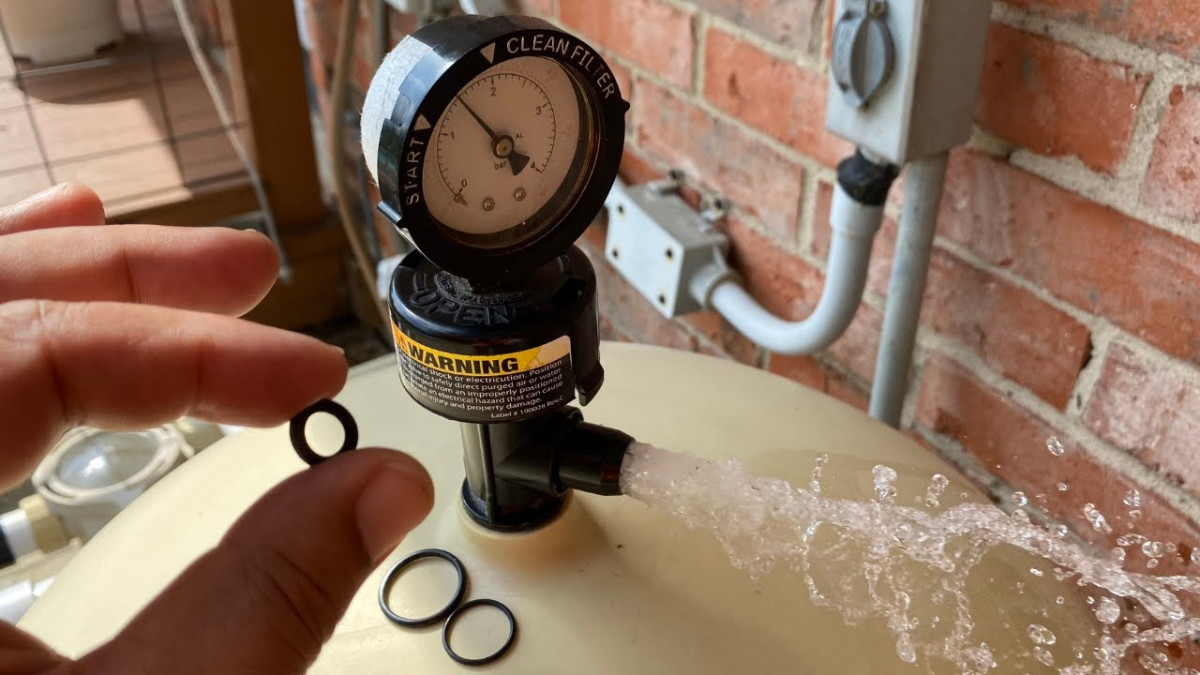Loss of prime in your pool pump surging noises and air bubbles that come out of your return lines into the pool indicate you probably have an air leak in your pool filter. Possible sources of this problem are low pool water levels to damaged gaskets that need replacement. This air can damage your pump and affect the proper circulation of your filter system. How do you get the air out of your pool pump?
- Bleed filter using air release on top of the filter
- Loosen pressure gauge to bleed system-open 1/4 turn until you see H2O
- Change the O-ring in the Pool Pump Basket Strainer
- Correct leaks/tightness of Unions & piping
- Add H2O to the pool
- Tighten the pump housing’s drain plugs
- Replace multiport valve gasket
- Re-prime system
Staying on top of your swimming pool’s operation equates to efficiency and efficiency will equate to time and cost savings from chemicals to electric energy bills. Being the Master of your pool no matter how big can give you an edge in running a trouble-free pool and spotting potential problems before they happen.
How to Get Air Out of Pool Pump
If your pool pump is surging or pulsing is most likely an air leak. The more pressure your pump creates can cause cracks from vibrations and loosen fittings. Making it easier it is for air to get sucked through the smallest leaks in your filtering system.

This is because air poses less resistance than water, it will get sucked by the pump instead of water, causing the pump to surge, pulse, and make a lot of noise that you will recognize as a potential problem.
Air leaks are located before the pool pump, which causes air to be sucked into the pump and causes a surge and gurgling noise. Any leaks after the pool pump will most likely leak out water because of the positive pressure on the other side. This all affects the circulation of the filtering system which will affect the operation of your pool filter.
- A pool Pump Losing Prime is a sure sign and if the pump runs dry after manually priming the pump, it could be a sign of a more severe air leak.
- Air Bubbles coming out in the pool are the most common sign you have air in your lines, air bubbles throughout your pool
- Air bubbles moving through the strainer pot, you know that the air leak is somewhere on the suction side of the system plumbing before or at the pump.
- Noisy pool pump surging and pulsing listening for any strange noise should be part of the pool’s care every day.
- Large air pockets through the lid of your pool pump-you can visually see large air bubbles at the lid of the strainer
- Large Surge of Bubbles in the pool when the pump kicks on spitting out of the pool filter.
If a big rush of bubbles enters the pool every time the pump turns on, and then subsides after a couple of minutes, you’re likely running the system with a substantial leak somewhere between the pump and your returns. It could be drawing air into the filter system while the pump is off.
This might happen as water from the pipes and/or filter drains back into the pool or out of the leak when the pump shuts down. When the pump turns back on, it forces this air out through the returns, causing a rush of bubbles that subsides after a minute or so.
-
Can Air Damage Pool Pump
Yes. The severity of this problem depends on just how much air is being pulled into your pool pump. If it’s a significant amount of air, there’s a possibility that your pump will become excessively noisy or stop working entirely. This is called Cavitation, where PVC pipes can crack at the joints or pieces of the filter system can be damaged.
There’s also a chance that your pump will overheat to the point of the equipment itself melting. Pool pumps are designed to work hard in the heat. As a fail-safe, most pool motors have a thermal disconnect designed to handle if the pump overheats, or worse, overheats to the point of catching fire.
To know if you have an air leak, you should first check the jets or returns mounted to the pool walls. If you see bubbles coming out of the jets, it’s a sign there is air in the pool system.

Air can potentially damage a pool pump in several ways:
- Cavitation: When air enters the pump’s system, it can cause cavitation. Cavitation occurs when air bubbles collapse within the pump, creating shock waves that can damage the pump’s internal components over time. This can lead to reduced pump efficiency and increased wear and tear.
- Overheating: Air in the pump’s system can disrupt the flow of water, causing the pump to work harder to maintain proper circulation. This increased workload can lead to overheating of the pump motor, potentially causing damage or premature failure.
- Loss of Prime: If air enters the pump’s suction side, it can cause the pump to lose prime. This means that the pump is no longer able to efficiently draw water from the pool, leading to decreased circulation and potential damage to the pump due to running dry.
- Corrosion: Air can carry moisture, which can lead to corrosion of the pump’s internal components over time. Corrosion weakens the structural integrity of the pump and can lead to leaks or other malfunctions.
To prevent air from damaging your pool pump, it’s essential to properly maintain your pool’s plumbing system, including regularly checking for leaks, ensuring proper water levels, and keeping the pump’s intake free from debris. Additionally, installing a properly sized and functioning air relief valve can help prevent air from accumulating in the pump’s system. Regular inspection and maintenance by a qualified technician can also help identify and address any potential issues before they lead to damage.
Air Relief on Pool Pump and Pool Equipment After Pool Cleaning
After completing pool cleaning, it’s crucial to check the air relief valve on your pool pump and other pool equipment. Begin by ensuring that the air relief valve is properly closed to prevent air from entering the system.

Next, inspect the surrounding area for any signs of leaks or damage that may have occurred during cleaning. Run the pump for a few minutes to ensure proper water circulation and to expel any remaining air from the system.
Finally, monitor the equipment for any unusual sounds or vibrations, which could indicate potential issues that need to be addressed. Regular checks after pool cleaning help maintain optimal performance and prolong the lifespan of your pool equipment.
Before moving on to bigger air leak problems start small and simply keep the pool pump on and bleed the filter using the air release at the top of the pool filter. Any type of Sand or Cartridge Filter should have an air release valve on the very top of the pressure gauge.
There are closed sand filter systems that don’t have an air release on the filter vessel. If that is the case then use the pressure gauge to bleed the system. Air will naturally collect at the highest point and in a filter, it would be at the pressure gauge where water will push it out.
If the filter does not have a bleeder valve at the top of the tank then simply loosen the pressure gauge at the very top of the filter vessel. (Don’t remove it) turn to the left-counter-clockwise just breaking the seal about a 1/4 turn on the fitting should do it.
This should move the air from out of the system and replace it with pool water. It’s a little messy but air will move to the highest point in your filtering system which will be at the pressure gauge. After you release the air you will hear a difference in the pool pump. Once you get the air out of the system you need to find out where it’s coming from.
Using Air Relief at Pressure Gauge on Pool and Pump
This should move the air from out of the system and replace it with pool water. It’s a little messy, but air will move to the highest point in your filtering system which will be at the pressure gauge. After you release the air, you will hear a difference in the pool pump.
Once you get the air out of the system, you need to find out where it’s coming from. One spot where you will notice air in a bubble is in the pump basket’s clear lid. If you open the lid and run hose water into the basket it will chase the air out as you prime the filter.
Air Relief from the Pressure Gauge on the Pool and Pump
Releasing air from the pressure gauge on your pool pump is a simple yet crucial maintenance task. Begin by locating the air relief valve, typically situated near the pressure gauge on the pump. With the pump turned off, gently turn the valve counterclockwise or pull up on the lever to release any trapped air.
Monitor the pressure gauge as you release the air, observing for any fluctuations that may indicate underlying issues. Once the pressure stabilizes, close the air relief valve and restart the pump to ensure proper circulation and prevent damage to the system. Regularly performing this procedure helps maintain optimal pump performance and prolongs the lifespan of your pool equipment.
This should move the air from out of the system and replace it with pool water. It’s a little messy, but the air will move to the highest point in your filtering system, which will be at the pressure gauge. After you release the air, you will hear a difference in the pool pump. Once you get the air out of the system, you need to find out where it’s coming from.
- Keep the pump and filter running.
- Let the filter system build up whatever pressure it can
- Loosen the nut under the pressure gauge to the left
- Check the air bubble in the pump basket
- let air come out of the system
- Tighten the nut once all air is released and a steady stream of water comes out.
How to Bleed Air From Pump Basket and Pump Strainer
Check the water level in the The ideal water level should be at least halfway up the skimmer intake. If the water level drops below that level, the skimmer can start to gulp air from the ebb and flow of circulating water.
Pool Pump Strainer Lid O-ring; The pump basket lid is sealed by a lid gasket which once it loses pliability can start to leak. Normal signs of wear are cracking in the rubber, warping, or stretching, and obvious, missing bits are inexpensive and should be changed once a season or after a pool cleaning. Check the rubber gasket for cracks pinching the gasket into a smaller loop at the start of the season.
A vacuum hose has a pinhole leak that will drive you nuts-they are very expensive hoses that should be stored away and taken care of to prevent damage from scraping and misuse. Tape the hose after locating the pinhole.

Threaded fitting or union -in front of the pool pump (suction side) check for leaks and the tightness of any threaded unions. You may see spray water suddenly, or drip water when you shut the pump off. Use dish detergent to locate an air leak on either side of the pool pump.
Why won’t my Pool Pump turn on?
- The external Power outage breaker tripped
- Pool timer-ensure that it reset to cycle properly
- Clogged Pump Impeller-Clean out impeller-Look for the reset button on the back motor
- Broken pump Capacitor
- Air locked
- Overheated motor from being covered
- The pump shaft is seized .……………………………………………………….. Read more
Air Bubble in Pump Basket of Pool Pump
If the airlock persists then you should try chasing air out of the pool lines by:
- Turn off the pool pump
- Shut down skimmers with valves or a plug
- Open the bottom suction line
- Turn on the pump and run for 30 seconds
- Open one skimmer at a time
- Then the other
- Use the air relief valve on the filter to chase air out of the system
- Return to filter position
- Prime the whole system using a garden hose to fill the return lines
What’s the Best Way to Prime a Pool Pump with a Sand Filter?
- Turn off the Pump-set multiport handle to recirculate
- Open-air pressure valve at top of Sand Filter-or loosen pressure gauge
- Open Pump Strainer-clean basket-check O-ring for wear
- Fill pump basket with hose-2-3 min.
- Close the lid-turn pump on
- Wait for air to be released at the pressure gauge………………………………………………. Read more

References:
MAYGO- How to Get Air Out of a Pool Pump [8-Step Guide]
FAQ’s
- What should I do if my pool pump loses its prime?
If your pool pump loses its prime, check for any clogs or air leaks in the suction lines, ensure the pump basket and strainer are clean, and verify that the water level is above the skimmer intake. You may also need to manually prime the pump by adding water to the pump basket and restarting the pump.
- How often should I backwash my pool filter?
Backwashing frequency depends on the type of filter and the pressure gauge readings. As a general guideline, backwash a sand filter when the pressure gauge reads 8-10 psi higher than normal, or for DE and cartridge filters when the flow rate decreases by 25%.
- Why is my pool pump making strange noises?
Strange noises from the pool pump could indicate issues such as cavitation, air leaks, worn bearings, or debris lodged in the impeller. Inspect the pump for any visible signs of damage or obstruction and address the issue promptly to prevent further damage.
